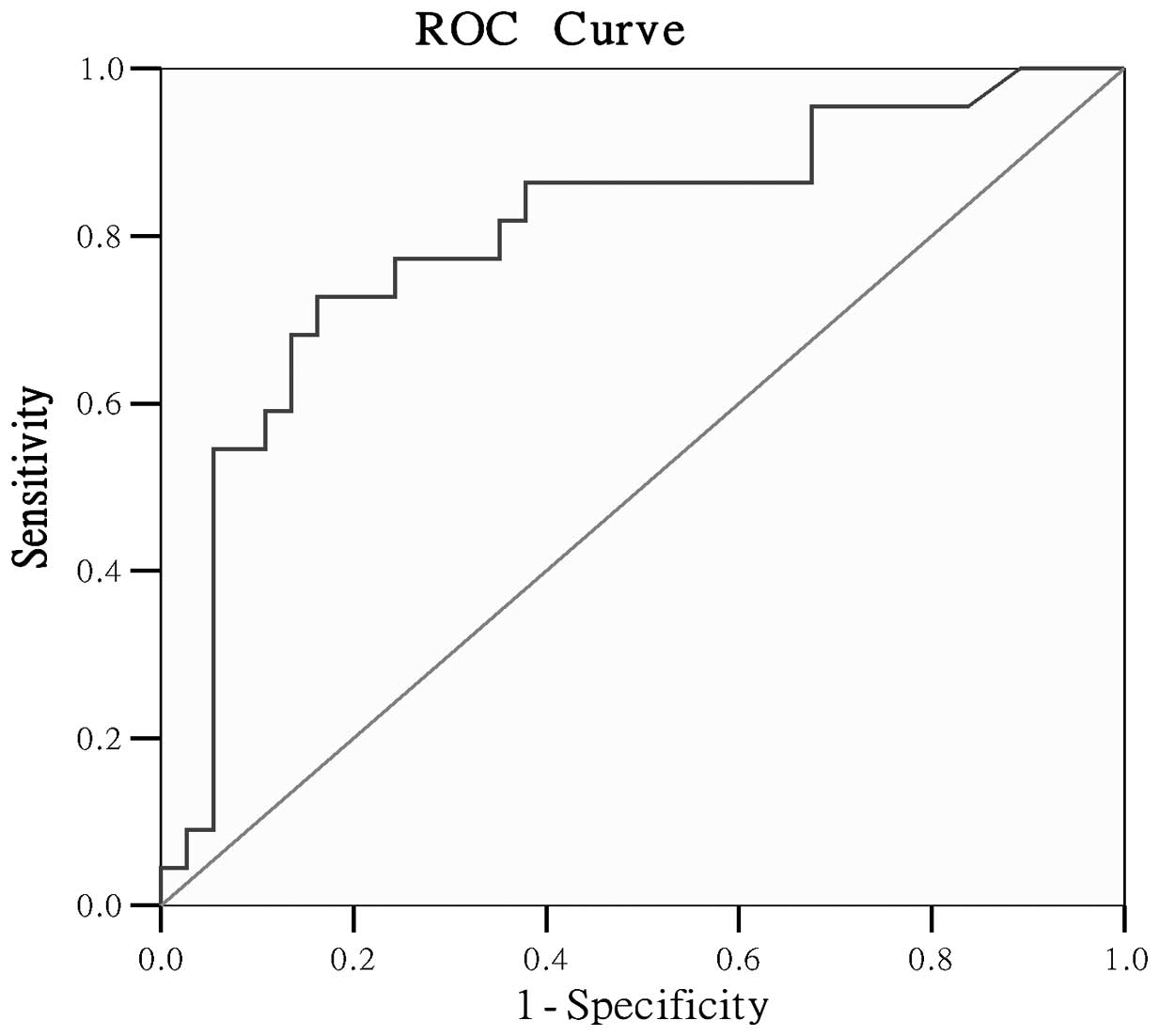|
1
|
Hiramine Y, Uto H, Imamura Y, Tabu K, Baba
Y, Hiwaki T, Sho Y, Tahara K, Higashi H, Tamai T, Oketani M, Ido A
and Tsubouchi T: Sorafenib and hepatic arterial infusion
chemotherapy for unresectable advanced hepatocellular carcinoma: A
comparative study. Exp Ther Med. 2:433–441. 2011.PubMed/NCBI
|
|
2
|
Curigliano G, Criscitiello C, Gelao L and
Goldhirsch A: Molecular pathways: human leukocyte antigen G
(HLA-G). Clin Cancer Res. 19:5564–5571. 2013. View Article : Google Scholar : PubMed/NCBI
|
|
3
|
No authors listed. Banff schema for
grading liver allograft rejection: an international consensus
document. Hepatology. 25:658–663. 1997. View Article : Google Scholar : PubMed/NCBI
|
|
4
|
Fluss R, Faraggi D and Reiser B:
Estimation of the Youden index and its associated cutoff point.
Biom J. 47:458–472. 2005. View Article : Google Scholar : PubMed/NCBI
|
|
5
|
Carosella ED, Moreau P, Lemaoult J and
Rouas-Freiss N: HLA-G: from biology to clinical benefits. Trends
Immunol. 29:125–132. 2008. View Article : Google Scholar : PubMed/NCBI
|
|
6
|
Onichtchouk D, Chen TG, Dosch R, Gawantka
V, Delius H, Massagué J and Niehrs C: Silencing of TGF-beta
signalling by the pseudoreceptor BAMBI. Nature. 401:480–485. 1999.
View Article : Google Scholar : PubMed/NCBI
|
|
7
|
Neumann UP, Langrehr JM, Lang M, Schmitz
V, Menzel S, Steinmueller T and Neuhaus P: Impact of HLA matching
upon outcome after liver transplantation. Transplant Proc.
34:1499–1500. 2002. View Article : Google Scholar : PubMed/NCBI
|
|
8
|
Baba Y, Sonoda JI, Hayashi S, Tosuji N,
Sonoda S, Makisumi K and Nakajo M: Reduction of oxidative stress in
liver cancer patients by oral green tea polyphenol tablets during
hepatic arterial infusion chemotherapy. Exp Ther Med. 4:452–458.
2012.PubMed/NCBI
|
|
9
|
Başaran O, Ozcay F, Karakayali H, Turan M,
Dalgiç A and Haberal M: Influence of HLA compatibility on success
with living-related pediatric liver transplantation. Transplant
Proc. 37:3151–3153. 2005.PubMed/NCBI
|
|
10
|
Contini P, Ghio M, Merlo A, Poggi A,
Indiveri F and Puppo F: Apoptosis of antigen-specific T lymphocytes
upon the engagement of CD8 by soluble HLA class I molecules is Fas
ligand/Fas mediated: evidence for the involvement of p56lck,
calcium calmodulin kinase II, and Calcium-independent protein
kinase C signaling pathways and for NF-κB and NF-AT nuclear
translocation. J Immunol. 175:7244–7254. 2005.PubMed/NCBI
|
|
11
|
Guillard C, Zidi I, Marcou C, Menier C,
Carosella ED and Moreau P: Role of HLA-G in the innate immunity
through direct activation of NF-κB in natural killer cells. Mol
Immunol. 45:419–427. 2008.PubMed/NCBI
|
|
12
|
Bahri R, Hirsch F, Josse A, Rouua-Freiss
N, Bidere N, Vasquez A, Carosella ED, Charpentier B and Durrbach A:
Soluble HLA-G inhibits cell cycle progression in human alloreactive
T lymphocytes. J Immunol. 176:1331–1339. 2006. View Article : Google Scholar : PubMed/NCBI
|
|
13
|
Favier B, LeMaoult J, Rouas-Freiss N,
Moreau P, Menier C and Carosella ED: Research on HLA-G: an update.
Tissue Antigens. 69:207–211. 2007. View Article : Google Scholar : PubMed/NCBI
|
|
14
|
Liang S, Zhang W and Horuzsko A: Human
ILT2 receptor associates with murine MHC class I molecules in
vivo and impairs T cell function. Eur J Immunol. 36:2457–2471.
2006. View Article : Google Scholar : PubMed/NCBI
|
|
15
|
Naji A, Le Rond S, Durrbach A,
Krawice-Radanne I, Creput C, Daouya M, Caumartin J, LeMaoult J,
Carosella ED and Rouas-Freiss N: CD3+CD4low and CD3+CD8low are
induced by HLA-G: novel human peripheral blood suppressor T cell
subsets involved in transplant acceptance. Blood. 110:3936–3948.
2007. View Article : Google Scholar : PubMed/NCBI
|
|
16
|
Ma Y, Wang GD, He XS, Li JL, Zhu XF and Hu
RD: Clinical and pathological analysis of acute rejection following
orthotopic liver transplantation. Chin Med J (Engl). 22:1400–1403.
2009.PubMed/NCBI
|
|
17
|
LeMaoult J, Caumartin J, Daouya M, Favier
B, Le Rond S, Gonzalez A and Carosella ED: Immune regulation by
pretenders: cell-to-cell transfers of HLA-G make effector T cells
act as regulatory cells. Blood. 109:2040–2048. 2007. View Article : Google Scholar : PubMed/NCBI
|
|
18
|
Feger U, Tolosa E, Huang YH, Waschbisch A,
Biedermann T, Melms A and Wiendl H: HLA-G expression defines a
novel regulatory T-cell subset present in human peripheral blood
and sites of inflammation. Blood. 110:568–577. 2007. View Article : Google Scholar : PubMed/NCBI
|
|
19
|
Caumartin J, Favier B, Daouya M, Guillard
C, Moreau P, Carosella ED and LeMaoult J: Trogocytosis-based
generation of suppressive NK cells. EMBO J. 26:1423–1433. 2007.
View Article : Google Scholar : PubMed/NCBI
|
|
20
|
Swets JA: Measuring the accurancy of
diagnostic systems. Science. 240:1285–1293. 1998. View Article : Google Scholar
|


















